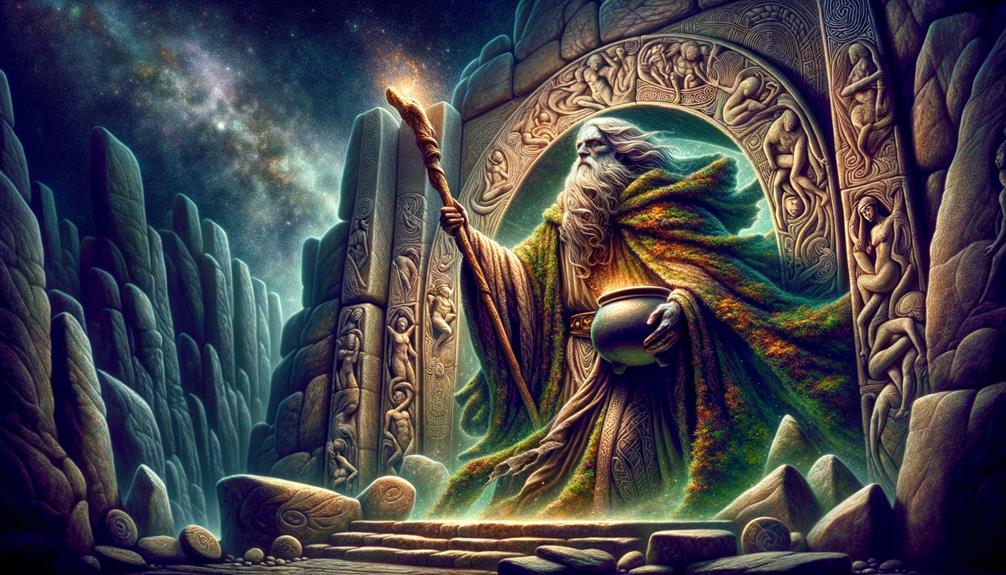The compelling world of Celtic mythology brings us the Dagda, a god who can be likened to an 'all-father'. This figure embodies a divine masculinity that is tied to wisdom, fertility, and strength. Known by names such as Eochaid Ollathair and Ruad Roftessa, these monikers paint a picture of a wise and formidable entity. He isn't just a patriarch to well-known personalities like Brigid and Aengus, but his influence also stretches across a complex network of divine and mortal connections. Dagda's holy relics, which include a club that gives life, an unending cauldron, and a mystical harp, all hold symbolic meaning. They signify his absolute authority and dual essence. His lasting impact can be traced in present-day Irish Pagan and Druidic practices. Moreover, his narrative and lessons continue to engage audiences. When you further probe into Dagda's mythology, you're bound to come across a wealth of enthralling stories.
The Dagdas Powerful Epithets
Let's get a bit chatty about the Dagda, a key figure in Celtic mythology. You've probably heard about his mighty titles, like Eochaid Ollathair and Ruad Roftessa, right? Eochaid Ollathair is a fancy way of saying 'all-father,' which really drives home his role as the big daddy of the gods. Clearly, he's not just a father figure, but also a wise one, knowing all there is to know and strong enough to handle it all.
Now, let's talk about Ruad Roftessa. This title, just like Eochaid Ollathair, is another badge of honor that tells us how significant Dagda is. It paints a picture of him as a force to be reckoned with, a figure of wisdom and power.
These titles do more than just sound cool. They give us a glimpse into Dagda's role in Irish folklore. They tell us that he's not just any god, but a key player, a figure of immense importance. In understanding these titles, we get a clearer picture of Dagda's character and his place in the grand scheme of things.
This isn't just about understanding a single character, though. It's about getting a deeper insight into the fascinating world of Celtic mythology. And in that world, Dagda stands as a wise authority and a father figure. So, next time you hear about Dagda, you'll know just how big of a deal he is.
Iconic Family of the Dagda
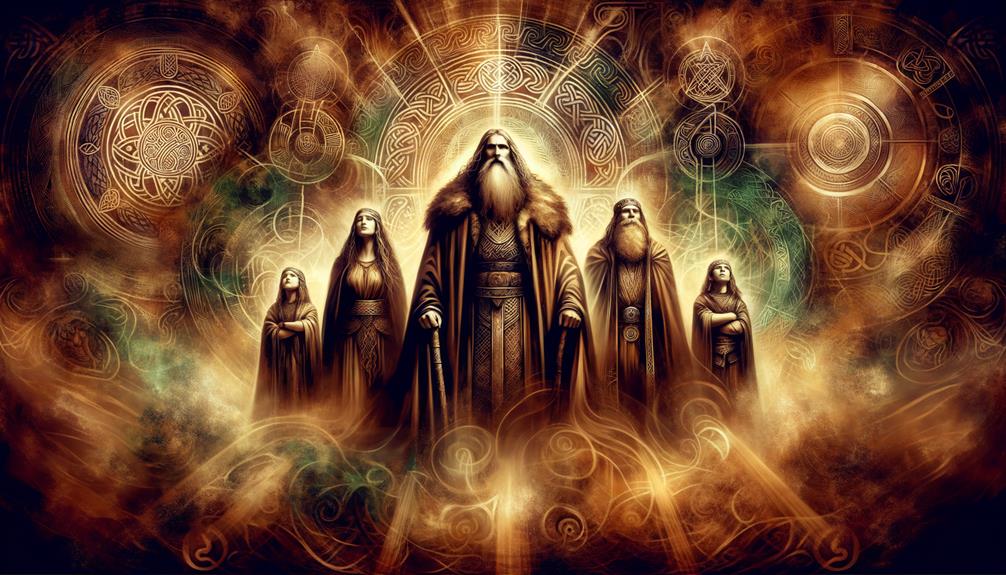
Let's have a chat about the legendary Dagda and his equally legendary family. His influence isn't limited to just his own being; he's the patriarch of some key figures in the deity world, like Brigid and Aengus. As a major player in the Irish Tuatha Dé Danann pantheon, Dagda's relationships are anything but simple.
Take his wife, Morrigan, for instance. She's not just any deity; she's a big deal in Celtic mythology. Then, there's Dagda's love affair with the river goddess, Boann. This relationship brought about the birth of Aengus, who eventually made his home at Brú na Bóinne. This is a testament to just how far Dagda's influence reaches.
This intricate web of connections, involving gods, goddesses, and even mortals, really highlights Dagda's role in Irish mythology. It's like a beautifully woven tapestry of divine and mortal interactions, and Dagda is at the heart of it all.
Dagdas Sacred Treasures Explored
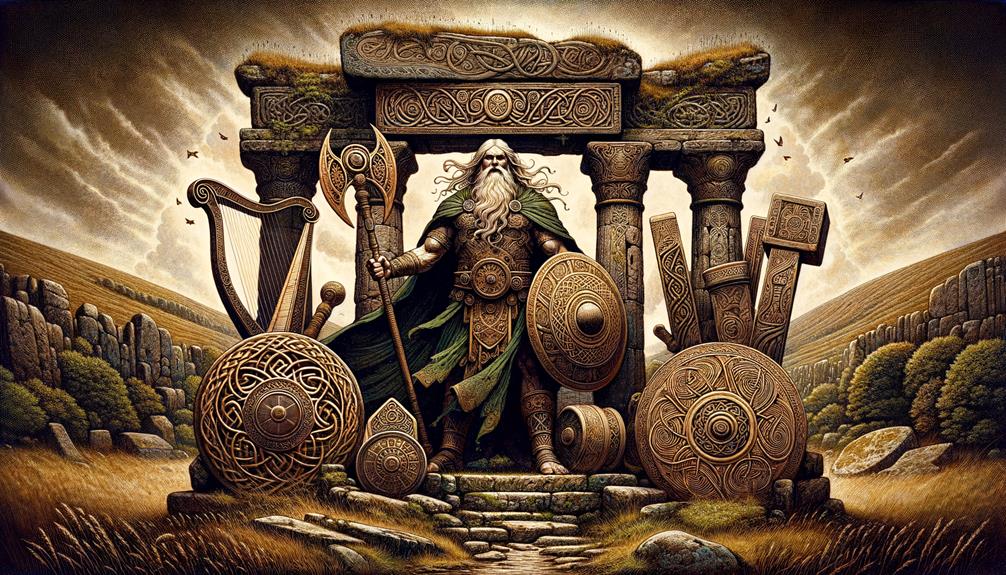
When we take a closer look at the sacred treasures of Dagda, a notable figure in Celtic mythology, we find three main symbols that represent his mighty power, deep wisdom, and commanding authority. These treasures include a cauldron that never runs dry, a club that can both give life and take it away, and a magical harp known as Uaithne.
The cauldron, never running dry, represents wealth and healing. The club, or the 'Club of Life', signifies the cycle of life and death. Uaithne, the harp, stands for emotional regulation and the shifting of seasons.
| Treasure | Symbolism | Power |
|---|---|---|
| Cauldron | Wealth & Healing | Ever-Full |
| Club of Life | Cycle of Life & Death | Gives & Takes Life |
| Harp – Uaithne | Emotion & Seasons | Regulation |
These three sacred treasures were used by Dagda to keep things balanced. Their importance in folklore supports Dagda's status and his role in Celtic mythology. They highlight the god's nature of duality, his ability to navigate the intricacies of life, and his supreme command.
When writing, keep it simple and clear. If a sentence seems too intricate, think about breaking it down or replacing flowery words with more straightforward alternatives.
Keep your language up-to-date, reflecting current happenings and common phrases. Avoid outdated or overly technical language unless it's necessary for the topic at hand.
Avoid cliches: the provided list contains several phrases and words that have been overused. It's best to avoid these. Instead, focus on fresh expressions or straightforward descriptions.
Instead of using generic transition words or phrases, aim for a smooth flow in your writing. Transitions based on the content can often be more effective.
Avoid exaggeration. While it might be tempting to use exaggerated language to make a point, this often subtracts from the credibility of an article. Stick to the facts and support your claims with evidence where possible.
Remember your audience. Adjust your language to suit the familiarity and knowledge base of your readers.
Choose active voice. An active voice makes your writing clearer and more direct. Choose this over passive voice whenever possible.
Instead of just stating that something is 'important' or 'essential,' explain why it's significant. This helps the reader understand better and makes the content more engaging.
Modern Influence of Dagda
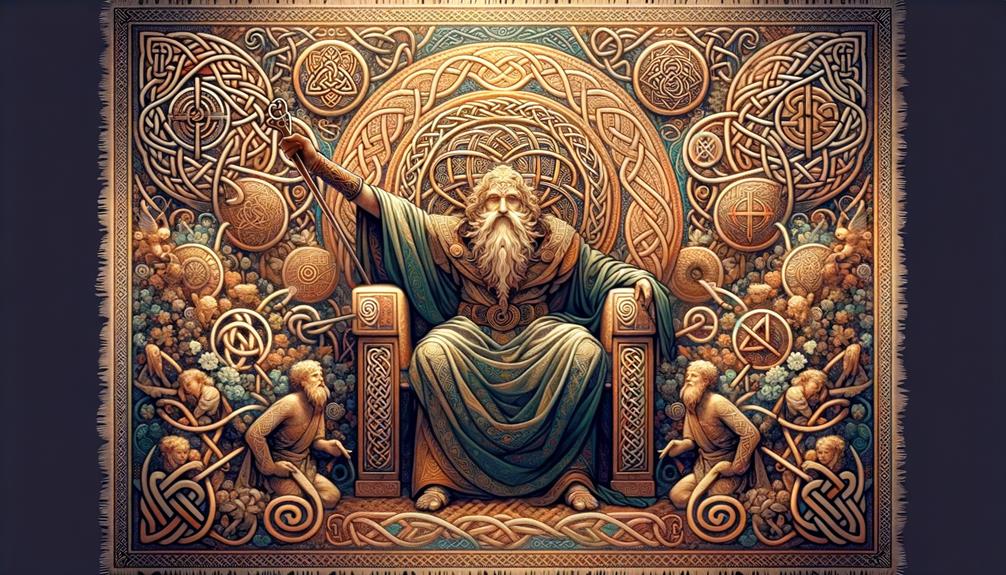
The tales of Dagda, with his power and wisdom, echo through time from ancient Celtic folklore right into our present day. Especially within Irish Pagan and Druidic traditions, his influence is still palpable. As the Father God of Ireland, Dagda's impact is undeniable. He's not just a character from an old story – his teachings about life's balance offer inspiration to today's thinkers. The qualities he embodied, like wisdom and power, are deeply respected, and his influence can be clearly seen in the arts today. He represents a strong link to Ireland's rich history and heritage. Among the pantheon of Celtic gods and goddesses – the Tuatha – Dagda's influence in our time remains robust, making him a lasting symbol for those with an interest in Celtic spirituality and mythology.
Deciphering Dagdas Mythology
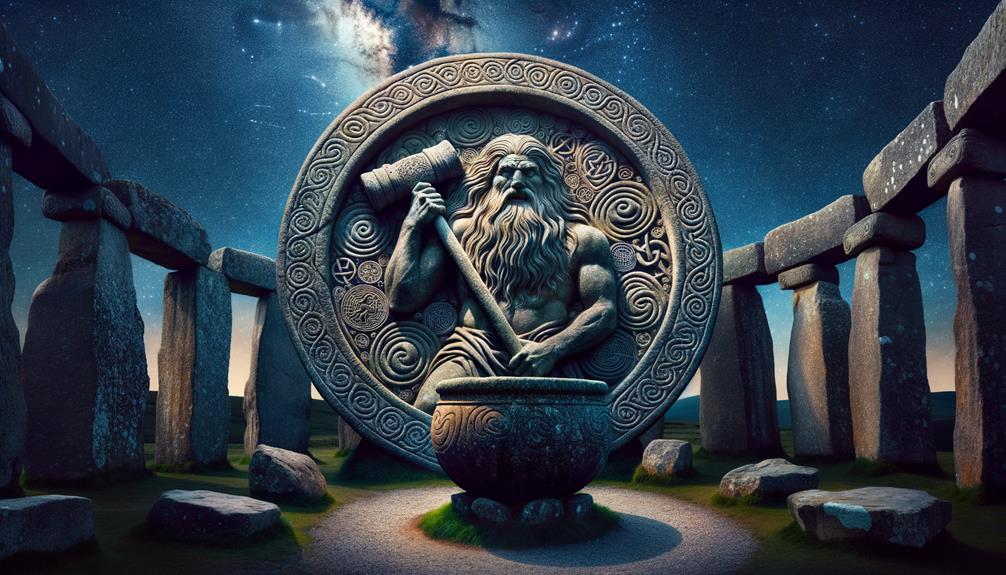
Exploring Dagda's mythology, we find a character immersed in divine masculinity. His tales are rich with themes of fertility, farming, magic, and wisdom. As the chief of the Tuatha, Dagda was a key player in the Battle of Mag Tuired, where he showcased his strength, taking down adversaries with a single hit. His ties to fertility are highlighted by his connections to the River Boyne and his daughter, Brigid. His ability to control life and the seasons, showcased by his ownership of the Cauldron of Plenty, reinforces his godly status.
| Mythological Element | Significance |
|---|---|
| Chief of the Tuatha | Leadership, power |
| Battle of Mag Tuired | Heroic courage |
| River Boyne & Daughter named Brigid | Fertility, life-creating |
| Cauldron of Plenty | Plenty, control over life |
Frequently Asked Questions
What Is the Story of the Dagda?
Oh yes, I know about the Dagda. He's a deity from Ireland who is celebrated for his intelligence and might. He possesses these amazing magical items that make him quite a character in Celtic mythology. Interestingly, he's the one with the power to control life and death, and he even has control over the divine kingdom.
Who Is the Father of the Dagda?
So, who's Dagda's dad? That's a great question! It's none other than Elatha. He's not just anyone, but the king of the Fomorians. Now, that's a fascinating bit of info, isn't it? You see, both the Fomorians and the Tuatha Dé Danann are key players in Irish mythology. This father-son dynamic adds an intriguing layer to Dagda's background and personal story. Makes you look at him in a whole new light, doesn't it?
What Was the Challenge Given to Dagda?
So, here's the thing, in the tale, Dagda was given this enormous task of finishing a massive bowl of porridge in one go. But guess what? He managed to pull it off! Using his enchanted cauldron, he cleverly gobbled up every last bit, not even sparing the hidden goodies. Just goes to show, when you're backed into a corner, that's when you get really creative.
What Are the Signs of Dagda?
Hmm, you're curious about Dagda, aren't you? Well, let's talk about him a bit. So, when it comes to his symbols, three things come to mind- a cauldron, a club, and a harp. And you can't ignore his eye-catching physical traits – his imposing size and that wild beard of his. Got the picture? Great! Those are what you might call the 'signs' of Dagda.

